#martin chalfie
Text
In 1955, Shimomura joined the lab of Yoshimasa Hirata at Nagoya University, where he was tasked with extracting the organic compound luciferin from ostracods and determining its precise molecular structure. Today, scientists know that in many bioluminescent organisms, an enzyme named luciferase catalyzes a chemical reaction between luciferin and oxygen, which produces light. But back then, “we didn’t fully understand how it happened,” Shimomura says. “It was a mystery.” After 10 months of labor in the lab, Shimomura became the first person to crystallize luciferin, an essential step in studying its structure.
In the 1960s, he continued his research at Princeton University, where he also started to investigate the luminous jellyfish Aequorea victoria. Shimomura and his colleagues collected numerous A. victoria specimens and strained them like cider apples to obtain a small amount of pure glowing “squeezate.” Within the shining liquid they discovered a protein they named aequorin, which releases blue light when it reacts with calcium, even in the absence of oxygen. Another protein in the jellyfish, green fluorescent protein (GFP), sometimes absorbs that blue light, and releases green light in response.
By 1978, after collecting nearly a million jellyfish, Shimomura had thoroughly elucidated the structure of aequorin and the nature of A. victoria’s unique light-generating reactions. Both aequorin and GFP—as well as the gene coding for the latter—became indispensable tools in biology and medicine. Scientists could now tag and observe the intricate dances of previously invisible genes and proteins in living cells. In 2008, along with Martin Chalfie of Columbia University and Roger Tsien of the University of California, San Diego, Shimomura received the Nobel Prize in Chemistry for his work on GFP.
— The Secret History of Bioluminescence
#ferris jabr#the secret history of bioluminescence#science#biology#microbiology#marine biology#chemistry#animals#medicine#shimomura osamu#hirata yoshimasa#martin chalfie#roger y. tsien#plankton#crustaceans#ostracods#jellyfish#aequorea victoria#luciferin#luciferase#aequorin#green fluorescent protein#bioluminescence#light
3 notes
·
View notes
Text
Bilimi Aydınlatan Moleküler Fenerler
Profesör Martin Chalfie, yeşil floresan proteini GFP‘nin keşfi ve geliştirilmesi nedeniyle Prof. Osamu Shimomura ve Prof. Roger Tsien ile birlikte 2008 yılında Nobel Kimya Ödülü’nü kazandı.
Parlayan Denizanası ve Mucizevi Bir Hata
Foto: Martin Chalfie ve Hikmet Geckil (Harvard Üniv., 2010)
Parlayan bir ateş böceğinin karanlık bir geceyi aydınlatması gibi şaşırtıcı derecede güzel bir fenomeni…
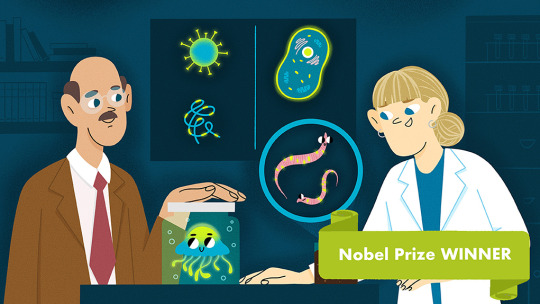
View On WordPress
0 notes
Photo
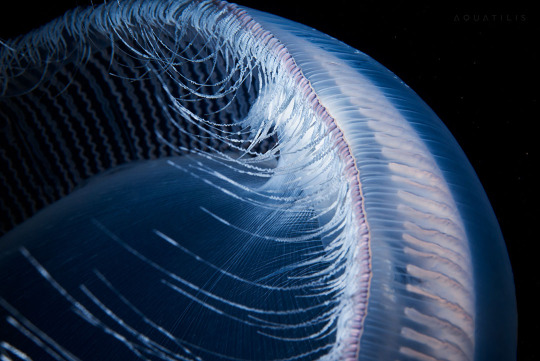
A Jellyfish Continues to Light the Way
Aequorea victoria is an almost entirely transparent and colorless jellyfish found off the west coast of North America. It is also bioluminescent, able to produce a kind of chemical light.
In 2008, the late Roger Tsien, PhD, a professor of pharmacology, chemistry and biochemistry at UC San Diego School of Medicine and two colleagues won the Nobel Prize in chemistry for discovering the gentle green light of crystal jellies (their common name) and translating it into new technologies that literally illuminated the world of science.
Specifically, Tsien, Osamu Shimomura and Martin Chalfie discovered and described the presence of green fluorescent protein or GFP and learned how to use it to light up molecular activities within living cells. Since then, GFP proteins have been broadly used across science and medicine, including fluorescence-guided surgery.
In a new paper, published November 2, 2020 in PLOS Biology, UC San Diego scientists report that Aequorea still has a few secrets to reveal: new fluorescent proteins that brightly expand the color spectrum. These new proteins, with novel attributes of their own, promise to give rise to a new generation of useful probes for bioimaging and biosensing.
— Scott LaFee
#science in photos#science#medicine#gfp#green fluorescent protein#bioimaging#fluorescence#marine biology#jellyfish#aequorea victoria#bioluminescence#chemistry#biochemistry#academic medicine#ucsd#uc san diego
15 notes
·
View notes
Text
Knock on the door late at night was a professor's Nobel co-winner notifying him of their win
New Post has been published on https://appradab.com/knock-on-the-door-late-at-night-was-a-professors-nobel-co-winner-notifying-him-of-their-win/
Knock on the door late at night was a professor's Nobel co-winner notifying him of their win



The committee calls the winners before announcing the names to the world each year. It’s always a decent hour in Stockholm — the middle of the day — but that means it is the middle of the night on the US West Coast.
But Milgrom couldn’t be reached, so his neighbor — and fellow prize winner — Robert Wilson stepped up and walked over to Milgrom’s house.
In a security camera video recording, Wilson is seen ringing Milgrom’s doorbell at 2:15 a.m. PT and knocking for several seconds. Finally, Milgrom responds.
“Paul, it’s Bob Wilson,” Wilson says. “You’ve won the Nobel Prize. And so they’re trying to reach you, but they cannot. They don’t seem to have a number for you.”
“We gave them your cell phone number,” Wilson’s wife, Mary, says.
A moment of silence follows.
“Yeah, I have? Wow,” Milgrom responds from the other side of the door.
“Will you answer your phone?” Wilson’s wife asks with a laugh.
Milgrom’s wife was in Stockholm. Because she received a notification from the doorbell security camera back home, she got to watch as Wilson relayed the good news, according to a tweet from Stanford University.
Milgrom and Wilson, both professors at Stanford University, received the prize for their work in auction theory.
The professors “used their insights to design new auction formats for goods and services that are difficult to sell in a traditional way, such as radio frequencies,” the Royal Swedish Academy of Sciences said in a statement.
“Their discoveries have benefited sellers, buyers and taxpayers around the world.”
It’s not the first time the call from Stockholm has been missed by an American winner.
In 2010, Martin Chalfie won the Nobel Prize in Chemistry along with Osamu Shimomura and Roger Y. Tsien, but he slept through the call.
“I woke up at ten after six, and I realised that they must have given the Prize in Chemistry, so I simply said, ‘Okay, who’s the schnook that got the prize this time?,” Chalfie said in a conversation with a Nobel.org representative that the Nobel Committee posted online. “And so I opened up my laptop, and I got to the Nobel Prize site and I found out I was the schnook!”
Appradab’s Isaac Engleberg contributed to this report.
0 notes
Photo

Commission for Ganga Library Online. Nobel Laureate Martin Chalfie for Chemistry 2008. Painted by artist Tim Tompkins PaintHistory.com/. http://www.gangalib.org/ #portrait #portraiture #nobelprize #historical #museum #library #washingtondc #peaceprize
#portrait #portraiture #nobelprize #historical #museum #library #washingtondc #peace
#art #artist #artistic #artwork #artistsontumblr #portraits #familyportrait #portraitpainting #portraitures #painting #paint #paintings #nobel prize #nobelprize #LivingHistory #painthistory #painthistorystudio #timtompkinsartist #portrait #portraiture #contemporaryart #fineart #artgallery #gallery #visualarts #arts #artists #painted #commission #laureate #history #chemistry #ganga #museums #paintingportrait #magazines #award #inspiration
0 notes
Text
2019搞笑諾貝爾獎揭曉!為什麼樹袋熊便便是方塊的?
搞笑諾獎(Ig Nobels)創立於1991年,是一項對於真正的科學皇冠“諾貝爾獎”的善意的滑稽模仿秀,其官方宗旨是“獎勵那些乍一看讓人發笑,但隨後卻能讓人深思的科學研究”。這個獎項每年會在哈佛大學劇場舉行發布會和頒獎典禮。典禮儀式包括有迷你音樂劇(每年的主題都不一樣),科學展示環節,還有24/7演講。

在這個環節,科學家必須在24秒內用專業語言闡述自己的研究工作,隨後再用7個字,用所有人都能聽得懂的簡單語言來解釋自己從事的工作。而有趣的是,所有獲獎者發表獲獎感言的時間也是被限制的,只有60秒,如果超時就會有一個8歲小女孩對著你大吼大叫:“快停下吧!太無聊啦! ”正如這一獎項的口號中所提到的那樣,每一年的獲獎項目,都是一開始讓你發笑,但是背後卻有重要科學意義的。
按照傳統,每一個獲獎團隊或個人將獲得:100萬億津巴布韋幣,這是搞笑諾獎的一個傳統。實際上在津巴布韋,由於驚人的通貨膨脹,這種紙幣早就不再流通了,事實上,由於巨額通脹,100萬億津巴布韋幣大約只能兌換40美分(大約2.8人民幣)。 2009年,搞笑諾貝爾獎將數學獎授予津巴布韋央行行長Gideon Gono,以表彰他“給予津巴布韋人民一種簡單,日常的學習巨大數字的方法——發行面額從1分到100萬億的貨幣。 ”

來看看今年都有什麼奇葩又有趣的研究獲獎了吧!
化學獎:

成果:“評估了一個典型5歲孩童每天的唾液分泌總量”
這項研究開展於1995年,來自日本的獲獎者評估了不同的食物(包括大米飯,香腸,土豆泥,曲奇餅乾,蘋果以及日式酸蘿蔔)對兒童唾液分泌量產生的影響。研究方法是這樣的:研究者首先對食物稱重,然後讓孩子先咀嚼這些食物,但是不能嚥下去,而是吐出來,隨後研究者再次稱重,以測量裡面多了多少唾液。唾液總體上是對人體健康有益的,它有助於保持口腔濕度,幫助消滅病菌並啟動對食物的消化過程。不過研究者未能在當年的論文中有說服力的表明,為什麼開展這項研究是值得的。
物理學獎
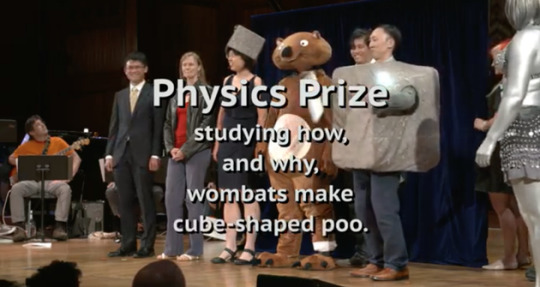
獲獎者:Patricia Yang,Alexander Lee,Miles Chan,Alynn Martin,Ashley Edwards,Scott Carver,以及David Hu
獲獎原因:研究了樹袋熊排出方形糞便的方式和原因
樹袋熊是已知的唯一一種會排出方形糞便的動物。佐治亞理工學院的一支研究團隊利用幾頭樹袋熊屍體,對這一現象展開了研究。結果發現,這種奇特的糞便與樹袋熊腸道的形狀和靈活性、以及樹袋熊生活的環境比較乾燥有關。該研究結論或許能幫助製造業改進方形產品的生產方法。

工程學獎
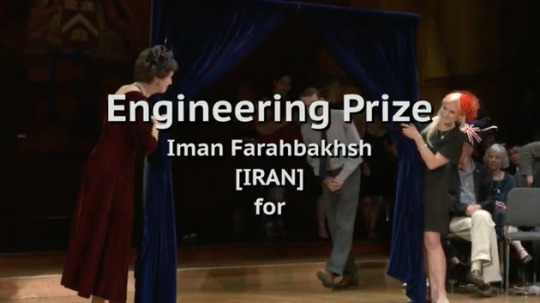
成果:“發明了一種適用於人類嬰兒的自動換尿布機”
新手父母們對於給寶寶換尿布的痛苦簡直太了解了。一位來自伊朗的工程師Farahbakhsh決定解決這個問題。他採用的思路和洗碗機很像。在申請的專利中,作者提到:“一旦將嬰兒放入其中,自動化的尿布更換程序將啟動,全程無需人工參與,無需接觸嬰兒或者尿布,程序將自動完成。”同時,使用這台機器將減少水的使用,去年,這項發明成功獲得美國專利。

解剖學獎
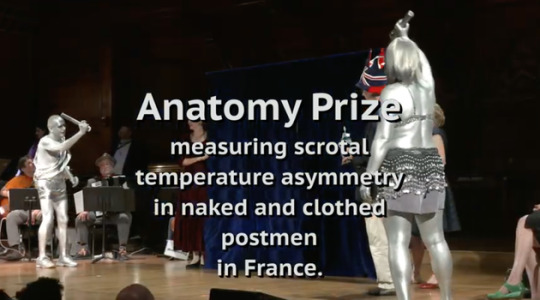
成果:測量了未穿衣服和穿衣服的法國郵遞員兩側陰囊溫度的不對稱性
科學界此前曾爭論過,男性的左側陰囊溫度是否比右側稍高一些。很多人都知道,有時左側陰囊的位置會略低於右側,這可能是為了避免兩個陰囊相互碰撞、也可能是為了更好地散熱降溫,而這兩點原因之間或許也有一定關聯。有一些研究顯示,兩側陰囊的溫度存在不對稱性,而有些研究則否定了這一點。因此此次獲獎者們決定自己開展研究一探究竟。他們分別測量了年輕的郵遞員在未穿衣服和穿衣服狀態下的陰囊溫度,結果發現兩側溫度的確不一致。研究人員總結道:“左右兩側陰囊的溫度差別也許在一定程度上導致了男性外生殖器的不對稱性。”
經濟學獎:

成果:“測定了哪個國家的紙幣最容易傳播危險的病菌”
該組研究人員在一篇發表於2013年的論文中指出:“全球範圍內,紙幣是人與人之間交換最為頻繁的物件之一。而在這種交換的過程中,紙幣可能遭到污染並可能在人與人之間的病菌傳播中扮演了重要角色。”為了驗證這一假設,研究人員故意污染了來自全球各地的各種紙幣,包括歐元,美元,加拿大元,克羅地亞庫那,羅馬尼亞列伊,摩洛哥迪拉姆以及印度盧比,研究人員在這些紙幣上塗抹了金黃色葡萄球菌和大腸桿菌的菌株。隨後觀察這些菌株在各類紙幣上能夠生存多長時間,以及在換手時,是否會傳播這些病菌。結果顯示,羅馬尼亞列伊是唯一一種兩種病菌都會被傳播出去的紙幣。原因可能是因為它使用的是聚合物材料。因此或許避免使用聚合物材料製作紙幣,或者乾脆推廣無現金支付手段,將是未來的大趨勢。

羅馬尼亞列伊
和平獎:
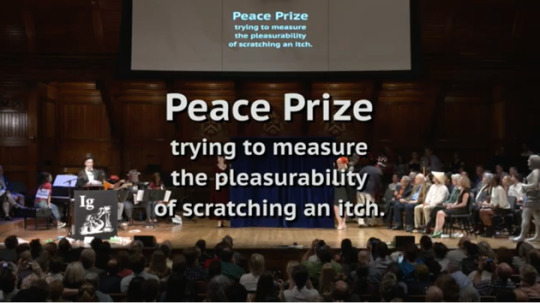
成果:“試圖測量撓痒癢帶來的愉悅程度”
試問天下有誰沒有享受過撓痒癢的快感?但是今年的搞笑諾獎和平獎獲得者們注意到,似乎還沒有人對撓痒癢究竟能有多麼舒服進行過定量化的測量研究。因此在他們2012年的這項研究中,他們使用一種熱帶豆科植物黎豆來引發身體各種不同部位的瘙癢感,包括前臂,腳踝,背部,腋窩等等。結果顯示,背部和腳踝處的瘙癢感要強於前臂,也因此在撓痒癢時,背部和腳踝處感受到的愉悅感也要強烈一些。

醫學獎
成果:證據表明食用披薩或有助於預防疾病、延年益壽,前提是要在意大利境內食用在意大利製作的披薩

2003年,Gallus和同事們分析了消化意大利披薩是否有助於預防癌症。 2004年,他們研究了披薩是否能降低患急性心肌梗塞的風險。 2006年,他們��進一步研究了食用披薩是否能降低患乳腺癌、卵巢癌和前臉腺癌的風險。 Gallus等人也承認,這些研究中發現的有益影響因素都可以歸結於健康的地中海式飲食。但對於披薩愛好者來說,這仍然是一次很重要的研究。

心理學獎:
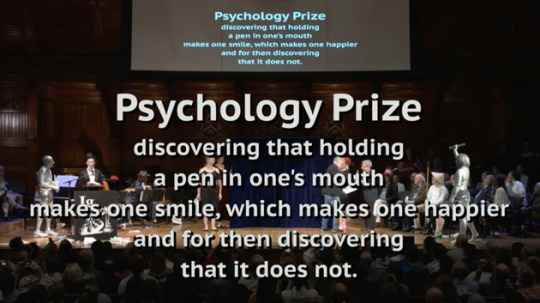
成果:“發現嘴裡叼一支筆會讓人微笑,因此也會更加快樂,但後來又發現事實並非如此”
時間退回到1988年,一個研究組發現,嘴裡叼一支筆會讓你微笑,也因此會更加快樂,這是一種面部反饋機制產生的結果。這在當時是一項相當有名的研究,也因此並沒有人去質疑它的結論,直到開展這項研究的科學家Strack自己在2016年重新對這個問題進行了研究和實驗,但卻發現無法復現當年自己得出的結論,換句話說:很遺憾,嘴裡叼一支筆,並不會顯著地增加你的快樂程度。

醫學教育獎
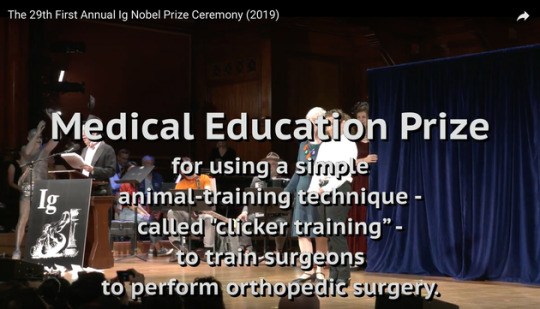
成果:利用一種名叫“響指訓練”的動物訓練方法,訓練外科醫生做骨科手術
這項研究開展於2016年,訓練內容為兩項手術任務:困難的打結、以及低角度鑽孔。研究人員想測試學習過程中“聲學反饋”的有效性。雖然該方法一般用於動物訓練,但此前有研究顯示,該方法或許也可用於訓練人類行為,並且比傳統的展示型教學方法更高效。研究人員指出,“響指聲”是一種不需要使用語言、也不涉及任何評判的條件強化手段。研究結果顯示,與對照組相比,使用“響指訓練法”的醫學生在學習任務時所花的時間更長,但開展任務的精確度更高。而精確度在外科手術中極為重要。

生物學獎
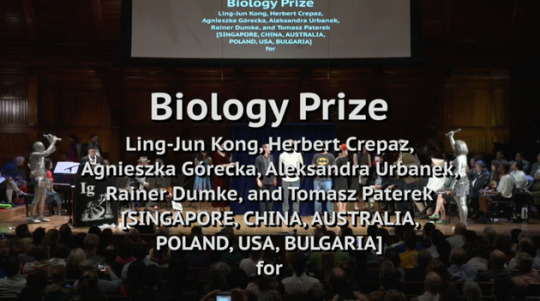
成果:發現被磁化的死蟑螂的行為與被磁化的活蟑螂不同
研究顯示,蟑螂及部分種類的昆蟲似乎能夠感知磁場的存在(即擁有“磁覺”),並且自身也可以被磁化。 Kong等人利用磁弛豫技術(MRX)測量了死去和活著的美洲大蠊的磁化與磁性消退速度。結果發現,活蟑螂磁性消退的速度比死蟑螂快得多。研究人員表示,這項研究不僅能幫助我們進一步了解動物感知世界的不同方式,或許還有助於改進人類受動物啟發製作的各類傳感器。
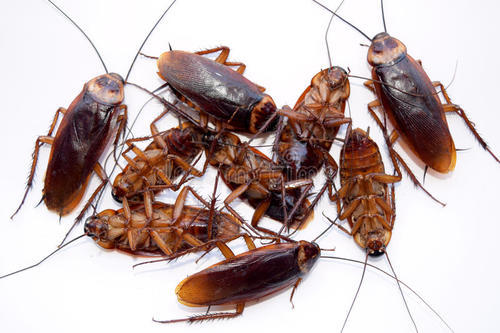
搞笑諾貝爾獎的那些事
1991年,馬克•亞伯拉罕(Marc Abrahams)創立了搞笑諾貝爾獎,這是對諾貝爾獎頒獎典禮的有趣模仿,與後者晦澀難懂的科學研究成果形成鮮明對比。搞笑諾貝爾獎由真正的諾貝爾獎得主頒獎,每次頒獎典禮都是“第一屆”。
馬克·亞伯拉罕對有趣和怪異的著迷還可以追溯到更久以前。亞伯拉罕成長於馬薩諸塞州的斯旺普斯科特(Swampscott),讀四年級時,他的好奇心被科學點燃了。他開始收集各種各樣“奇怪的東西”,包括一篇標題為《男子沖廁所,房子爆炸》的報紙文章,這些都讓年僅10歲的他得到想像力的極大滿足。
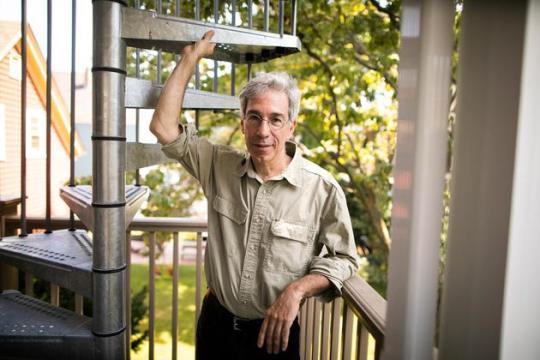
搞笑諾貝爾獎的發起者馬克·亞伯拉罕
亞伯拉罕畢業於哈佛大學應用數學專業,現年78歲。當地時間9月12日,他將在哈佛大學桑德斯劇場主持第29屆首屆搞笑諾貝爾獎的頒獎典禮。法國《世界報》(Le Monde)稱亞伯拉罕為“不可思議科學的教皇”,《華盛頓郵報》則稱他為“美國學術垃圾的專家”。
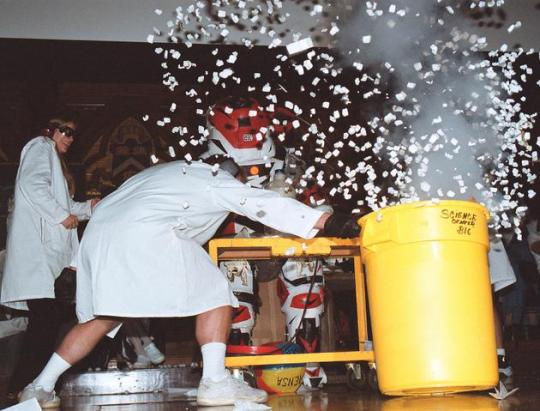
搞笑諾貝爾獎的頒獎典禮都很熱鬧,1999年,科學家在頒獎典禮上引爆一個裝滿五彩紙屑的大桶
往屆的獲獎者包括一位出生於烏克蘭的研究者,他設計了一種可以變成防毒面具的胸罩;一位對人類肚臍絨毛做過全面調查的澳大利亞科學家;還有一位發明了洗貓狗機器的西班牙發明家。
如今,亞伯拉罕是一位編輯兼作家,他說:“作為一個成年人,我要做所有我小時候最喜歡做的事情。”他的家庭辦公室裡擺滿了搞笑諾貝爾獎的紀念品。每年,亞伯拉罕都會像一位經驗豐富的領唱一樣,主持這場熱鬧的盛會,並精心策劃當晚的惡作劇。頒獎典禮中,還有觀眾向舞台投擲紙飛機,以及由真正的諾貝爾獎得主頒獎等傳統環節。
預計今年將出席頒獎典禮的諾獎得主包括2007年諾貝爾經濟學獎得主埃里克•馬斯金(Eric Maskin);1990年諾貝爾物理學獎得主杰羅姆·弗里德曼(Jerome Friedman );以及2008年諾貝爾化學獎得主馬丁·查爾菲(Martin Chalfie)。
不可思議的科學
搞笑諾貝爾獎頒獎典禮在諾貝爾獎頒獎前舉行,旨在表彰“乍看讓人發笑,之後發人深省”的科學成就,並強調科學甚至可以存在於一些荒謬的問題中,比如“嘆氣就只是嘆氣嗎?”(回答:不,這是一種無意識的消極情緒的表達,包括渴望、無聊、失望和失敗);或者“端著咖啡走動時,咖啡為什麼會溢出來? ”(答案:這是杯子運動和里面的低粘度液體動力學相互作用的結果)。
亞伯拉罕是科學幽默雜誌《不可思議研究年報》(Annals of Improbable Research)的聯合創始人兼編輯。 “我們把人們的注意力引向了一些可能根本得不到太多關注的事情,”他說,“諾貝爾獎得主會得到認可,但還有數百萬名科學家在推動科學,而他們中的大多數人根本得不到任何關注。”
舉個例子,有一群醫生研究了激烈接吻的生物醫學益處和後果,還有研究人員證明幾乎所有體重在3公斤以上的哺乳動物都在21秒內排空膀胱,甚至有科學家研究了馴鹿對偽裝成北極熊的人類的反應。
搞笑諾貝爾獎還表彰了那些沒有獲得應有認可的創新者。他們當中有卡拉ok的發明者,有提出墨菲定律的三個人,還有一個人和他的父親一起為“comb-over”髮型(把一邊頭髮全都梳到另一邊頭髮稀少的地方)申請了專利。
獲得搞笑諾貝爾獎並不容易。每年,亞伯拉罕和一組志願的評委都會評估數千項提名。一些被選中的人因為害怕在公眾面前難堪而拒絕接受該獎項,但大多數人都很激動,願意支付親自領取該獎項的旅費。
1991年,第一屆搞笑諾貝爾獎頒獎典禮在麻省理工學院的一間教室裡舉行,自此之後,這個活動就在全世界的科學家中逐漸贏得了聲望,而且一直很受歡迎。三年後,頒獎典禮搬到了哈佛大學桑德斯劇場,並且每年都在那裡舉行,觀眾爆滿。
起初,一些科學家痛斥搞笑諾貝爾獎,稱其是為了嘲笑科學研究,但真正的諾貝爾獎得主的出現消除了這種觀點。大多數科學家都會欣然接受這一獎項,因為這表明他們可以自嘲,並鼓勵人們對科學產生興趣。
“有些人認為我們是在攻擊科學,取笑科學家,”亞伯拉罕說:“但我們其實是在為科學家們辯護,他們試圖找出什麼是真實的,什麼是真實的,什麼是準確的。我們想讓人們對科學充滿好奇。人們會害怕他們不理解的東西,但如果他們在感到害怕之前擁有好奇心,科學就不會再讓他們感到害怕了。”
搞笑諾貝爾獎並不妨礙科學家獲得真正的諾貝爾獎。 2000年,英國曼徹斯特大學皇家學會研究教授安德烈•海姆(Andre Geim)因研究用磁懸浮技術使活青蛙浮起而獲得搞笑諾貝爾獎。十年後,他以石墨烯(一種比鋼強度更高的超薄材料)的開創性實驗獲得2000年諾貝爾物理學獎。
安德烈·海姆在自己的簡歷中列出了“搞笑諾貝爾獎得主”,他說:“坦白地說,我對搞笑諾貝爾獎和諾貝爾獎的評價是一樣的。對我來說,搞笑諾貝爾獎是我能開玩笑的表現;一點點的自嘲總是有幫助的。”
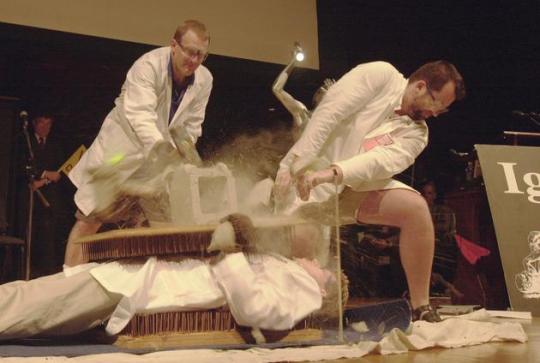
哈佛大學講師丹尼爾·羅森伯格(左)在2001年搞笑諾貝爾獎頒獎典禮上對同事尼爾斯·索倫森進行“胸口碎大石”,後者當時躺在釘���上
搞笑諾貝爾獎至今已舉辦了28屆,其獎項包括生物、醫學、物理、和平、經濟、文學等固定獎項,也包括公共衛生、考古、營養學等隨機獎項,所有獲獎的成果都是實際存在的研究。參與獎項評審的評委包括《不可思議研究年報》的編輯、各領域的科學家(包括幾位諾貝爾獎獲得者)、記者和多個國家不同領域的精英人士。創始人亞伯拉罕曾表示,搞笑諾貝爾獎的設立是為了表揚不尋常的研究、推崇想像力,並“激起人們對科學、醫學和技術的興趣”。
想知道又不敢問的問題:
讓我們來回顧一些過往得獎的有趣成果。
2008年
營養學獎:好聽的食物也會比較好吃。吃薯片時聽到的咔嚓聲,能讓人感到薯片比實際的更新鮮脆爽。
2009年
和平獎:裝滿啤酒的啤酒瓶比空啤酒瓶更結實嗎?它們的斷裂閾值是否足以打破人類的頭骨?研究這兩種啤酒瓶打人的效果,有助於幫助法庭判斷二者造成的傷害。
2010年
和平獎:和很多人想像的一樣,罵人確實能夠緩解疼痛。
2011年
心理學獎:嘆氣就只是嘆氣嗎?其實,嘆氣可以作為對困難任務的情感信號反應。
2012年
流體力學獎:端咖啡走路如何不灑出來?除了人走路方式的影響外,咖啡晃動的情況還與加速度和扭矩等有關。
2013年
心理學獎:情人眼裡出西施?喝醉酒的人會認為自己變得更加迷人。
2014年
神經科學獎:在吐司上看到耶穌的臉?這證明了“人臉空想性錯視”的存在,當人們觀察到類似人臉的特徵時,某些神經元會活躍起來,將這些特徵整合成一張臉。
2015年
物理學獎:幾乎所有體重在3公斤以上的哺乳動物排尿時間都在21±13秒內,不隨身體大小而改變。
2016年
醫學獎:當你左邊身體癢時,可以通過照鏡子撓自己的右邊來緩解,反之亦然。
2017年
解剖學獎:為什麼老年人有大耳朵?男性30歲後,耳朵每10年都會生長約2毫米,相比女性而言,大耳朵更為顯眼。
2018年
醫學獎:藉由坐過山車可以加速腎結石排出。
人類學:在動物園裡收集證據,證實了黑猩猩模仿人類的頻率與人類模仿黑猩猩的頻率一樣,且做得一樣出色
生物學:證實了葡萄酒專家可以通過氣味識別葡萄酒杯中是否有蒼蠅存在
化學獎:通過測量發現,人類唾液可作為骯髒物體表面的良好清潔劑
醫學教育獎:發表了一篇醫學報告——坐姿結腸鏡檢查:從自我結腸鏡檢查中獲得的教訓
文學獎:記錄了多數使用複雜產品的人們都不會去閱讀說明書
營養學:計算出了吃人肉所攝入的卡路里熱量遠低於從其它傳統肉食中攝入的卡路里熱量
和平獎:在駕駛車輛時測量大聲叫喊和罵人的頻率、動機和效果
生殖醫學獎:用郵票測試男性性器官是否正常,他們的研究報告描述稱,使用郵票監測分析夜間男性陰莖勃起
經濟學:研究了僱員使用扎小人詛咒老闆是否能緩解焦慮
.
from 2019搞笑諾貝爾獎揭曉!為什麼樹袋熊便便是方塊的?
via KKNEWS
0 notes
Text
Nobel chemist and GFP discoverer Osamu Shimomura dies aged 90
Nobel chemist and GFP discoverer Osamu Shimomura dies aged 90
Osamu Shimomura, who shared the 2008 chemistry Nobel prize with Martin Chalfie and Roger Tsien for the discovery of green fluorescent protein (GFP) has died of natural causes at his home in Nagasaki, Japan, aged 90.
In the 1960s he isolated GFP from the luminous jellyfish Aequorea victoria and showed that it glowed green under UV light. Others then went on to show how the gene for GFP can be…
View On WordPress
0 notes
Text
Fallece a los 90 años el Nobel de Química japonés Osamu Shimomura
Fallece a los 90 años el Nobel de Química japonés Osamu Shimomura
[ad_1]
El químico y biólogo marino japonés Osamu Shimomura, galardonado en 2008 con el Premio Nobel de Química por el descubrimiento y desarrollo de la proteína verde fluorescente (GFP), ha fallecido a los 90 años, informaron hoy los medios locales.
Shimomura, quien obtuvo el premio junto a los estadounidenses Martin Chalfie y Roger Tsien, murió en la ciudad de Nagasaki, en el sudoeste de…
View On WordPress
0 notes
Text
ENCONTRAR LO INESPERADO DONDE NO TE LO ESPERAS. MI PROPIO CASO DE SERENDIPIA: Cómo descubrir una especie en un tarro de judías
Aquí podéis leer un ensayo con dos partes claramente diferenciadas: en la primera se habla sobre el concepto de serendipia y algunos famosos ejemplos (uno de ellos muy biológico), mientras que en la segunda parte se habla de cómo se puede descubrir una nueva especie en el lugar menos esperado
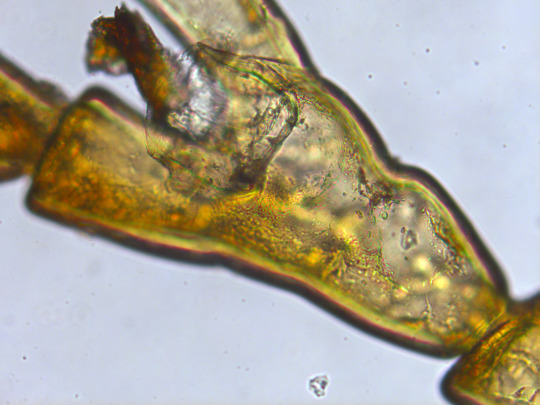
Serendipia. Un término muy extendido y que casi todo el mundo conoce y, no obstante, he decidido hacer una entrada del blog sobre este término ¿Está justificado? Bueno, veremos que hablar de serendipia no es más que una excusa para contaros mi breve, pero intensa, experiencia personal con la casualidad. Serendipia es una palabra de nuevo cuño, por tanto un neologismo (y que, por tanto, no proviene de ningún idioma antiguo o vernáculo), creado por el cuarto conde de Orford, Horace Walpole, un político e intelectual inglés del siglo XVIII, conocido por crear el género literario del terror gótico con su obra “El Castillo de Otranto”. Walpole en 1754, observando un cuadro (actualmente perdido) de Giorgio Vasari, que hacía referencia al cuento tradicional Persa “Los tres príncipes de Serendip” –según contaba en una carta a su amigo Horace Mann– se dio cuenta de su propia “suerte” al descubrir lo que el cuadro encerraba: los tres príncipes de Serendip solucionaban sus problemas con carambolas y casualidades imposibles y este adjetivo, a saber, personas que solucionan sus problemas sin buscarlo, no tenía homólogo en inglés. Ocurrió entonces lo lógico: denominó serendipity a esta característica. Serendip era el antiguo nombre de Sri Lanka o Ceilán, una gran Isla situada en la costa occidental de la India y la palabra deriva del sánscrito “Simhaladvīpah” pronunciado en árabe Sarandib. Walpole había descubierto por casualidad que un lugar muy lejano de Inglaterra, con tres príncipes agraciados, podía describir su propio hallazgo: serendipia.
Pero, el lugar en el que se ha hecho famoso este concepto, a lo largo del siglo XX, es la ciencia. La más conocida de todas las serendipias fue la de Alexander Fleming, que dejó una placa petri con cultivos bacterianos destapada y, tras unos días de cultivo a la temperatura adecuada, creció en ella un hermoso hongo que, para sorpresa del propio Fleming, había creado un halo alrededor suyo donde el crecimiento de la bacteria era nulo. No crecían bacterias. Había nacido la era de los antibióticos con el descubrimiento de la penicilina, producida por ese maravilloso hongo verde-azulado del género Aspergillus. Quizá esta sea una de las más importantes de la historia de la ciencia pero ni mucho menos la única. Otro gran descubrimiento fortuito relacionado con nuestra salud fueron los rayos X. A finales del siglo XIX Wilhelm Conrad Rötgen se encontraba estudiando la extraña fluorescencia violeta que emitían los llamados rayos catódicos: corrientes de electrones que se producían en tubos que solo contenían el gas de interés popularizados (pero no fue el inventor) para la investigación por el físico británico William Crookes; tubos llamados desde entonces tubos de Crookes o de rayos catódicos. Algunos investigadores que trabajaron con ellos se dieron cuenta que producía imágenes borrosas cuando los tubos se encontraban cerca de placas fotográficas (placas de vidrio con soluciones sensibles a la luz la más antigua de las cuales es el colodión una solución a base de sulfato de hierro amoniacal). Rötgen no estaba estudiando nada nuevo, siemplemente estaba ampliando los conocimientos sobre el comportamiento de los rayos catódicos en tubos con gases muy rarificados (a muy bajas presiones) y, para ello, estudió si esa fluorescencia era capaz de atravesar un cartón oscuro que envolvía el tubo de rayos catódicos ¿Qué ocurrió? El día 8 de noviembre de 1895 Rötgen vio algo extraño. Había diseñado una placa de papel impregnada en cianuro de bario y platino porque sospechaba que alguna radiación podía escapar al cartón negro, pero lo que no esperaba es que esta radiación produjera, también, fluorescencia. Así lo describió el mismo:
“Cuando se deja pasar la descarga de una bobina de Ruhmkorff [...]o cualquier otro tubo parecido [como el de Crookes], cubierto con una camisa ceñida de cartón negro y fino, y en la habitación totalmente a oscuras se deja una placa de papel previamente recubierta de una capa de cianuro de bario y platino, ésta se ilumina cada vez que se produce una descarga, independientemente de que la superficie recubierta esté apuntando o no hacia el tubo. Dicha fluorescencia se produce hasta 2 metros de distancia del aparato. Es fácil convencerse de que la fluorescencia proviene del aparato de descarga eléctrica y no de cualquier otra parte de la línea.” (2)
Como vemos, todavía habla de fluorescencia, así que no esperaba hallar un nuevo tipo de radiación. Pero eso fue lo que ocurrió y acabó recibiendo el Premio Nobel por ello en 1905:
“Durante los experimentos posteriores, descubrió que objetos de diferentes grosores interpuestos en la trayectoria de los rayos mostraban una transparencia variable cuando se registraban en una placa fotográfica. Cuando inmovilizó por unos momentos la mano de su esposa en el camino de los rayos sobre una placa fotográfica, observó después del desarrollo de la placa una imagen de la mano de su esposa que mostraba las sombras arrojadas por los huesos de su mano y la de un anillo que llevaba puesto, rodeado por la penumbra de la carne, que era más permeable a los rayos y por lo tanto arrojaba una sombra más tenue. Esta fue la primera "röntgenogram" [radiografía] jamás tomada. En otros experimentos, Röntgen demostró que los nuevos rayos se producen por el impacto de los rayos catódicos en un objeto material. Debido a que su naturaleza era desconocida, les dio el nombre de rayos X. Más tarde, Max von Laue y sus alumnos demostraron que son de la misma naturaleza electromagnética que la luz, pero difieren de ella solo en la frecuencia más alta de su vibración. (3)”
Hay muchos ejemplos de serendipia en la ciencia y, antes de empezar con mi propia historia, me gustaría comentar el caso de Osamu Shimomura, un químico orgánico y biólogo marino que, junto a al estadounidenses Martin Chalfie (uno de los primeros en usar el descubrimiento de Shimomura) y Roger Y. Tsien, de origen chino (y que modificó y amplió el descubrimiento), recibieron el Premio Nobel de química en 2008. ¿Qué descubrimiento realizó Shomomura? Con su formación de químico, consiguió aislar y purificar dos proteínas que emitían fluorescencia excitadas a una determinada longitud de onda y que las presentaban dos organismos marinos que cobijaban a bacterias simbiontes, responsables últimas de la producción de dichas proteínas: la luciferina del copépodo Cypridina hilgendorfii y la proteína verde fluorescente del hidrozoo Aequorea aequorea. En su primera etapa como investigador consiguió aislar la luciferina tras meses de duro trabajo de laboratorio. Como él mismo explica:
“Intenté cristalizar la luciferina purificada, pero todos mis esfuerzos terminaron en precipitados amorfos, y cualquier luciferina sobrante se volvió inútil por la oxidación a la mañana siguiente. Entonces tuve que repetir la extracción y purificación una y otra vez. Trabajé muy duro e intenté todos los métodos de cristalización que pude pensar, sin éxito. Diez meses más tarde, sin embargo, finalmente encontré que la luciferina se podía cristalizar en un solvente altamente inusual. El solvente que encontré fue una alta concentración de ácido clorhídrico. Utilizando la luciferina cristalizada, pudimos determinar las estructuras químicas de la luciferina y sus productos de oxidación” (4).
Esto fue importante porque, esta perseverancia, y el hecho de encontrar una solución improbable aunque lógica; una solución que ya había demostrado ser válida le preparó ara su siguiente batalla.Frank Johnson, de Princeton, invitó a Shomomura a su laboratorio para servirse de sus conocimientos en química orgánica. Al poco de llegar Johnson informó a todo el equipo que esta interesado en comenzar a estudiar la bioluminiscencia de la medusa Aequorea aequorea. Como explica Shomomura: “En ese momento, era una creencia común pensar que la luz de todos los organismos bioluminiscentes se producía por la reacción de la luciferina-luciferasa”. Reacción que, como hemos visto, el ayudó a conocer al cristalizar el enzima implicado.
“tratamos de extraer luciferina y luciferasa de los anillos de la medusa. Probamos todos los métodos que pudimos pensar, pero todos nuestros esfuerzos fracasaron. Después de unos pocos días de trabajo, nos quedamos sin ideas. Estaba convencido de que la causa de nuestro fracaso fue la hipótesis luciferina-luciferasa que dominaba nuestras mentes. Le sugerí al Dr. Johnson que nos olvidemos de la idea de extraer luciferina y luciferasa y, en cambio, tratar de extraer una sustancia luminiscente, cualquiera que sea. Sin embargo, no pude convencerlo. Debido al desacuerdo sobre el método experimental, comencé a trabajar solo en un lado de una mesa, mientras que, en el otro lado, el Dr. Johnson y su asistente continuaron sus esfuerzos para extraer luciferina. Fue una situación incómoda e incómoda” (4).
Algo verdaderamente lamentable ¿Por qué no llegaron a ponerse de acuerdo? ¿Estaría implicado el sistema jerárquico que suele darse en los departamentos y centros de investigación en la producción de semejante situación? La cabezonería y el empecinamiento son con la razón. La razón todo el mundo cree tenerla. La cabezonería y el empecinamiento todo el mundo dice no tenerlo. Pero los tres están igualitariamente repartidos por toda la población. Así se produjo la serendipia. Un trabajador del conocimiento que es apartado del trabajo principal y casi situado en el ostracismo comienza a pensar sobre lo que sabe y lo que no. Se cuestiona su conocimiento. Se pregunta si realmente están extrayendo luciferina y, sobre todo, se basa en la lógica. La historia sobre cómo llegó a conseguir el método para extraer la sustancia bioluminiscente de estos hidrozoos [y sus bacterias simbióntes] es maravillosa y no me veo capaz de sustituir a la prosa original de Shomomura [traducida, eso sí]. Así describe el proceso que le llevó al descubrimiento:
“Dado que la emisión de luz significa consumo (pérdida) de sustancia activa bioluminiscente, la extracción de éstas [...] debe realizarse en condiciones que inhiban reversiblemente la reacción de luminiscencia. Por lo tanto, traté de inhibir reversiblemente la luminiscencia con varios tipos de inhibidores de enzimas y proteínas. Lo intenté muy duro, pero nada funcionó. Pasé los siguientes días [...] tratando de descubrir lo que faltaba en mis experimentos y en mi pensamiento. Pensé día y noche. A menudo cogía una barca de remos en el medio de la bahía [de Friday Harbor, llena a rebosar de Aequorea aequorea y donde si situó finalmente el laboratorio de Johnson en 1961] para evitar la interferencia de la gente. Una tarde, una idea repentinamente me golpeó estando en la barca. Fue una idea muy simple: "La reacción de luminiscencia probablemente implica una proteína. De ser así, la luminiscencia podría inhibirse de forma reversible a un determinado pH". Inmediatamente volví al laboratorio y probé la luminiscencia de los órganos livianos [órganos donde viven las bacterias simbiontes de Aequoria productoras de la luminiscencia] a varios valores de pH. Observé claramente la luminiscencia a pH 7, 6 y 5, pero no a pH 4. Traté los órganos livianos en un tampón de pH 4 y luego filtré la mezcla. El filtrado, libre de células, estaba casi oscuro, pero recuperó la luminiscencia cuando lo neutralicé con bicarbonato de sodio. El experimento demostró que podía extraer la sustancia luminiscente, al menos en principio. Pero una gran sorpresa vino después: cuando arrojé el extracto por el fregadero, el interior del fregadero se iluminó con un destello azul brillante. El desagüe de uno de los acuarios del laboratorio fluía hacia el fregadero, así que descubrí que el agua de mar causó la luminiscencia. Debido a que se conoce la composición del agua de mar, descubrí fácilmente que los iones de Ca2+ activaban la luminiscencia. El descubrimiento de Ca2+ como activador sugirió que el material de luminiscencia podría extraerse utilizando el conocido quelante de calcio EDTA” (4).

Figura ilustrativa de una de las colonias de Oswaldella, en este caso, Oswaldella terranovae. Los pólipos defensivos se encuentran en unas pequeñas protuberancias dentro de casa internodo. También por detrás de los pólipos hidrantes. Los pólipos reproductores no son visibles
Pues bien, también puedo hablar en primera persona cuando nos referimos a serendipias. Nos situamos temporalmente a principios de 2017. La persona con la que llevo trabajando desde 2012, Álvaro Luis Peña Cantero, y yo, decidimos realizar una actualización y revisión de todo un género de hidrozoos antárticos. Quizá algo rutinario para una persona que lleva más de veinte años trabajando con hidrozoos; quizá algo árido para una persona que empieza a adentrarse en el mundo de la investigación. Al igual que estáis pensando muchos al llegar a estas líneas, pensé en huir como un zorro pillado en un gallinero. “¿Bichos del hielo a mi? Paparruchas”, me dije a mi mismo, pero hubieron dos cosas que me reengancharon enseguida (bueno, en realidad fueron tres, pero la tercera tiene que ver con requisitos académicos para finalizar un programa académico así que, no cuenta). La primera es que, la historia del descubrimiento y descripción del género Oswaldella es una de esas historias de la ciencia molonas. No de esas donde todo acaba bien, si no donde hay acusaciones, platos por los aires y malos humos. “Buena magra”. La segunda es que resulta que los hidrozoos juegan un papel vital en uno de los ecosistemas más grandes del planeta: la plataforma continental de la Antártida. ¡Y el género Oswaldella es uno de los más diversos de toda al Antártida! Vayamos por partes.
Para hacernos una pequeña idea de la importancia de estos organismos hay que pensar en ellos como los equivalentes marinos de los grandes herbívoros terrestres. ¿Qué ocurre con los pastos cuando no son pastados por los herbívoros? Las especies de más porte y/o con una mayor rapidez reproductiva, como por ejemplo las gramíneas, dominan, lo ocupan todo y la comunidad se simplifica. Este efecto (que el ramoneo de los herbívoros contribuye a mantener una elevada diversidad herbácea en los prados) ya fue observado por Charles Darwin. Así, los hidrozoos, junto con el conjunto de animales, que constituyen un todo funcional en los ecosistemas acuáticos, y que englobamos bajo el concepto trófico de “filtradores”, mantienen a raya las grandes explosiones poblacionales de algas, también llamadas blooms y, por tanto, evitan la simplificación de las comunidades fitoplanctónicas. Este fenómeno fue estudiado por C. B. Officer y sus colaboradores (5) en poblaciones de bivalvos y demostraron que éstos son esenciales para evitar los blooms.
Pero, ¿Es esto cierto también para el caso de los hidrozoos antárticos? Normalmente, las plataformas continentales no van más allá de los 500m de profundidad, con largos tramos de solo 100-200m. Este suele ser el hogar habitual de los hidrozoos en el mundo. Pero, en la Antártida, el peso del casquete polar sobre la masa continental hace que la plataforma se sitúa a unos increíbles 800-1000m de profundidad. Aquí, a primera vista, parece mucho más difícil la conexión rápida entre fitopláncton y “herbívoros”. Hay un grupo de investigación del Institut de Ciències del Mar (CSIC) en Barcelona que está trabajando sobre este asunto y han descubierto que los hidrozoos Antárticos juegan un papel importante. C. Orejas Saco del Valle, uno de los componentes de este grupo, ha realizado varios trabajos en esta línea. Concretamente, en uno de ellos, afirma:
“El principal papel de los suspensívoros antárticos parece estar relacionado con el reciclaje eficiente de la producción de la columna de agua, que solo se asimila parcialmente durante el hundimiento de las partículas de zooplancton i otros consumidores secundarios. […] La información disponible, junto con nuestros datos preliminares, nos permite hipotetizar que los suspensívoros bentónicos pueden alimentarse de plancton de muy pequeño tamaño y partículas resuspendidas durante el invierno antártico, al menos, para compensar sus costes metabólicos, o para continuar su reproducción mediante la inversión en el crecimiento durante el período de alimentación más favorable, es decir, el verano”(6).
En otras palabras, los hidrozoos antárticos, no operarían como “grandes herbívoros terres”, si no como los hongos del suelo, reciclando la materia orgánica en suspensión del agua, incorporándola a sus cuerpos y, con el tiempo, las corrientes oceánicas, y las surgencias de estas a la superficie, contribuir a un eficiente uso de la misma. En otro trabajo de este grupo de investigación (7), con otros expertos en hidrozoos como Josep-Maria Gili, consiguieron estimar la dieta de cuatro especies de hidrozoos antárticos, entre ellas una de las especies que trabajé, Oswaldella antartica. Los autores encontraron que la cavidad gastrovascular (cavidad análoga a nuestro estómago) de los especímenes de esta especie vacía en el 77% de los casos, y en el caso de poseer presas en su interior, el 94% de esas presas eran diatomeas. En otras especies estudiadas, como Tubularia ralphii, encontraron que, del 71% de individuos con presas, el 87% de estas eran copépodos. Resumiendo:
“explotan la comida disponible, tanto estacionalmente, como la dispuesta en parche o aquella de tamaño microscópico. La actividad y la producción del bentos antártico no se detiene durante el invierno, ni si quiera procesos de oogénesis. El papel de los suspensívoros en las comunidades bentónicas aún está lejos de estar claro, pero tiene que jugar un papel principal tanto en los procesos de acoplamiento pelago-bentónicos, como en el reciclaje de la materia orgánica” (7).
Una vez he atraído la atención de los lectores preocupados por la funcionalidad de los conocimientos adquiridos, describiré la serendipia que tuve hace poco más de un año y que ha culminado, recientemente, con la descripción de una nueva especie. El género que escogimos para revisar y actualizar fue el género Oswaldella, como he dicho. La historia de este género es larga. Los primeros individuos fueron hallados a principios del siglo XX y descritos por A. Billard (pero cambiados al nuevo género de Oswaldella por Stenkow en 1919 y con un artículo bastante duro contra Billard. Concretamente fue duro contra sus habilidades como zoólogo). Actualmente hay 27 especies descritas del género y, junto a la familia en la que está clasificada, Leptothecata, suponen el 20% de la diversidad de hidrozoos antárticos. ¡Casi nada! Además, es un género endémico de la región (salvo una especie, que ha sido capaz de colonizar algunas regiones del cono sudamericano).
Tras la publicación de la actualización y revisión del género de hidrozoos (8), nos dimos cuenta de que, tanto macroscópicamente, como microscópicamente, y con la información disponible de algunos estudios genéticos realizados, habían dos especies con una morfología demasiado similar como para ser consideradas distintas (9). Así que solicitamos el material tipo, depositado en el museo de historia natural de Londres. Estas dos especies eran Oswaldella terranovae y Oswaldella stepanjantsae (Fig. 1).

Figura 1. Oswaldella stepanjantsae (izq.) y Oswaldella terranovae (drcha.). Como vemos, en principio parecen bastante diferentes. Ramificación (A), gonoteca (I, izq. - h, drcha), hidrotecas (esa cubierta en forma de taza) de los internodos rectas, en un caso, y de apertura ovalada en O. terranovae, etc.
Al revisar la bibliografía nos dimos cuenta que algo no cuadraba. Cuando se revisaba la bibliografía del género, se veía que ambas especies eran similares. Los análisis genéticos confirmaban que estaban estrechamente emparentadas. Pero cuando relizamos los estudios al microscópio electrónico de barrido, presentaban mucha variación en sus componentes morfológicos. Era como si, cada material que analizásemos, se presentara ante nuestros ojos como una nueva especie. No era posible. En este género y, en general, en el resto de hidrozoos coloniales, no es raro observar variabilidad intraespecífica: las colonias crecen y no son iguales los individuos de la base de la colonia, más viejos, que los individuos del ápice. Pero, en este caso, los pólipos defensivos que se presentan en la base de cada ramificación, variaban entre 2 y 8, presentándose a veces sobre montículos, a veces protegidos, a veces desnudos. Y, en concreto este carácter en el género Oswaldella nos demasiado variable. Todo era tremendamente inusual.
¿Qué podría estar ocurriendo? Cuando nos llegó el material hicimos un estudio morfológico completo, al microscopio electrónico de barrido y al óptico. Al principio todo seguía siendo confuso porque la variabilidad no desaparecía hasta que, en uno de los repasos semanales de las fotos obtenidas y pensar sobre el problema que teníamos delante, la verdad se reveló como se reveló ante los tres reyes de Serendip. Llevamos cuatro muestras estudiadas al microscopio electrónico y, exceptuando la primera, había empezado a aparecer un patrón: dos pólipos defensivos en la base de la ramificación, una hidroteca alta y recta, un pólipo defensivo en la protuberancia del internodo con una protección realmente formidable y el que se encontraba por detrás de la hidroteca con un aro protector (Fig. 2). Todo era nuevo, pero era constante. Incluso se parecía mucho a una muestra muy escasa ya catalogada como algo no asignable a ninguna de las especies de Oswaldella conocidas, pero claramente del género. Observamos de nuevo el material al microscopio óptico y ahí estaba la respuesta: había dos colonias distintas dentro del mimos frasco que contenía el holotipo de la especie Oswaldella stepanjantsae. El holotipo es el material de referencia que se toma como referencia de una especie. Pues bien. Ahí habían dos especies. Y no solo eso. Pudimos comprobar que a lo largo de la colonia de Oswaldella stepanjantsae, el número de pólipos defensivos en la base de la ramificación variaba, pero no eran dos: eran 4 (a veces, 6) y se presentaban normalmente un par de ellos en montículos. Esto la hacía morfológicamente idéntica a Oswaldella terranovae. Además, las diferencias observadas en los demás aspectos fueron atribuibles a cambios en la posición de la cual se tomaba la muestra de la colonia. Es decir, estábamos ante la misma especie. Por el otro lado, el material “extraño” no correspondía con nada observado hasta ahora. Por lo visto, este material se había “colado” durante la clasificación e identificación del material de Oswaldella stepanjantsae con tan mala fortuna que, ni si queira, era material de otra especie ya conocida del género, o de otra especie de otro género, otra familia u otro orden. No, ¡era una especie nueva! Los holotipos se guardan en sencillo tarros de conservas así que, puedo decir con una sonrisa en la boca, que me encontré una nueva especie en un bote de judias (10).
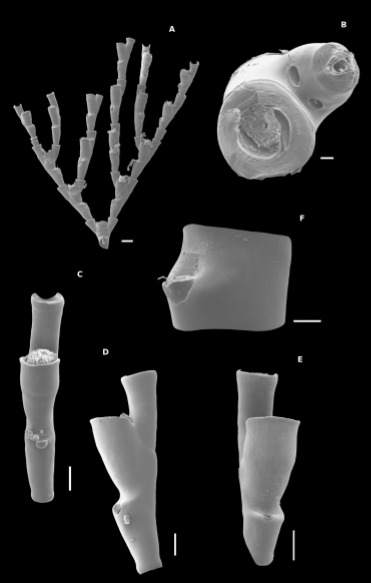
Figura 2. Oswaldella occulta. El número de pólipos defensores, que en este caso son 2 (B) y la forma de los internodos (C-E), la hidroteca y los pólipos defensivos de los internodos son muy diferente
REFERENCIAS
Pérez-Tamayo, R. (1980). Serendipia: ensayos sobre ciencia, medicina y otros sueños. Siglo XXi.
CSIC – Cristalografía. 2. Los Rayos X. Thu. 16 Aug 2018,
Wilhelm Conrad Röntgen – Biographical. NobelPrize.org. Nobel Media AB 2018. Thu. 16 Aug 2018.
Shimomura, O. (2009). Discovery of green fluorescent protein (GFP)(Nobel Lecture). Angewandte Chemie International Edition, 48(31), 5590-5602.
Officer, C. B., Smayda, T. J., & Mann, R. (1982). Benthic filter feeding: a natural eutrophication control. Marine ecology progress series, 9(2), 203-210.
Orejas Saco del Valle, C. (2001). Role of benthic cnidarians in energy transfer processes in the Southern Ocean marine ecosystem (Antarctica). Berichte zur Polar-und Meeresforschung.
Orejas, C., Gili, J. M., Arntz, W. E., Ros, J., López, P. J., Teixidó, N., & Filipe, P. (2000). Benthic suspension feeders, key players in Antarctic marine ecosystems?. Contributions to Science, 2000, vol. 1, num. 3, p. 299-311.
Molinero, A. G., & Cantero, A. P. (2015). SEM study of species of Oswaldella Stechow, 1919 (Cnidaria, Hydrozoa, Kirchenpaueriidae), with an annotated checklist of the species of the genus. Zootaxa, 4052(4), 401-441.
Cantero, A. L. P., & Marques, A. C. (1999). Phylogenetic analysis of the Antarctic genus Oswaldella Stechow, 1919 (Hydrozoa, Leptomedusae, Kirchenpaueriidae). Contributions to Zoology, 68, 83-94.
Cantero, A. P., & Molinero, A. G. (2018). On several species of Oswaldella Stechow, 1919 (Cnidaria, Hydrozoa), including the description of a new species. Zootaxa, 4457(3), 397-414.
0 notes
Link
Quincy Bioscience was established in 2004 and started selling Prevagen, a supplement containing apoaequorin, in 2007. Vitamin D was later added to the formula, about a year prior to this writing. It was suggested that apoaequorin may improve memory by binding to excess calcium in neurons.
Apoaequorin
Apoaequorin is a protein found in the Aequorea victoria jellyfish. Apoaequorin has 3 sites where it can bind calcium. When bound to calcium, the protein luminesces. These luminescent and calcium-binding qualities attracted attention from researchers in the 1960s. In 2008, Osamu Shimomura, Martin Chalfie, and Roger Y. Tsien were awarded the Nobel prize for Chemistry for the discovery and development of the green fluorescent protein GFP, found in the same jellyfish with similar applications. These fluorescent proteins have been researched and used as markers of protein synthesis and calcium presence.
Calcium and Memory
Factors that affect memory include amyloid, acetylcholine, glutamate, oxidative stress, and calcium. Neurodegeneration is associated with increased calcium levels in neurons. The production of calcium binding proteins in neurons decreases with aging. Here enters interest in the calcium binding property of apoaequorin. When neurons are studied in a laboratory environment, apoaequorin binds calcium and prevents neuron death.
Apoaequorin in the Human Body
There are a few hurdles to getting a calcium binder such as apoaequorin to brain neurons. After ingestion it must first travel from the the gastrointestinal tract into the blood, then travel through the blood without binding blood calcium and cross the blood brain barrier. Apoaequorin is a protein. In the stomach, the digestive enzyme pepsin breaks down proteins, including apoaequorin. Apoaequorin is described as a rapidly digested protein. This makes the protein rather tolerable and inactive.
Prevagen
The Madison Memory Study is a 90 day clinical trial of Prevagen available on the Quincy Bioscience website. The control group was given rice flour as a placebo with no noted protein in it. The treatment group experienced improvements in various test scores. However, the control group also experienced significant improvements in multiple test scores.
The clinical significance of the change in test scores was not discussed, and the individuals’ Reliable Change Index was not calculated as recommended by CogState, the developer of the testing tools. Only the improvements in verbal learning and recall were reported in the published part of the Madison Memory Study. The improvement in the treatment group was identified as a 7.41% increase in words recalled. That is less than one word from a list of 12, meaning the results may not be enough to have any significant impact on daily life, if any improvement at all could be attributed to the supplement.
While apoaequorin has had desired results in a laboratory environment, the oral supplement in a human body has not proven effective. The protein apoaequorin is digested in the stomach environment. And the trial using the Prevagen supplement was shown practically insignificant in improving memory.
Possible Solution
A computer model suggests that binding apoaequorin with cholesterol molecules might solve the problem. Cholesterol might be able to protect the apoaequorin from being digested in the stomach, help it be absorbed into the lymph system, and aid it in crossing the blood-brain barrier. It still needs to be shown that this complex can be made, and that it is able to be transported through the human body to the brain. Ultimately, it will need to be demonstrated that oral consumption of the modified complex results in improvement in memory.
Better Memory Supplements
When considering adding a nootropic to your regimen here are some factors to consider.
First, look for clinical trials that show effectiveness in humans. Research on neurons in controlled laboratory environments helps to understand how a compound may impact neuron function, but it does not take into account the challenges of delivery.
An example of the type of study to look for when considering supplementation was conducted on bacopa. In the randomized, double-blind, placebo-controlled trial, it was found that bacopa supplementation for 12 weeks improved measures of delayed recall and Stroop task (a measurement of focus), while the placebo group remained unchanged. Depression and anxiety scores improved in the bacopa group, while the scores worsened in the placebo group. It was also noted that heart rate decreased in the bacopa treated group. These findings agree with similar findings in other studies.
Second, look up the risk for medication interaction, toxicity, and contraindications (health conditions the supplement could exacerbate).
And third, purchase from a company that standardizes its products and responsibly seeks out quality suppliers.
Originally published at thrivous.com on May 16, 2018 at 05:26PM.
0 notes
Text
First Ever Science Symposium Coming to the Lehigh Valley located in Pennsylvania
Allentown, PA: Dr. Sam Ghosh of Ghosh Orthodontics is proud to announce details about the Valley’s first ever science symposium. This free conference is exclusive for middle and high school students from around the state and nearby regions, and includes speakers, exhibitions, and scholarships.
ScienceBuzz 2018 Symposium is scheduled for Saturday, June 9, 2018 from 9:00 AM – 5:00 PM at Parkland High School, Allentown, PA (Lehigh County). This free conference is exclusive for middle and high school students from around the state and nearby regions, and includes speakers, exhibitions, and scholarships.
Distinguished speakers, scientists, professors, and icons from across the globe including Government category, Francis Collings (tentative); Nobel Laureate category, Martin Chalfie (tentative, to be confirmed); Education category, Rene Islas; and Biopharma category, Binodh Desilva.
The event is brought to you by platinum sponsor Coordinated Health and bronze sponsor R.P. Mills Associates, Inc.
Dr. Ghosh is heavily vested in the event, because his Son, Roy Ghosh, is hosting the event.
Roy Ghosh is a current senior at Parkland High School and has participated in science fairs and research internships for the past six years. He has been an intern at the National Institutes of Health for the past two years, performing research on metastatic cancers and chemotherapeutics. Before then, during middle school and as a freshman, Roy had been an independent researcher at Lehigh University’s Bionanomechanics Lab.
He is a Siemens Semifinalist, two-time National Junior Science and Humanities finalist, International BioGENEius Challenge finalist, National Brain Bee finalist, two-time National Science Olympiad finalist and Silver Medalist, and Second Prize Winner in Biomedical Sciences at the International Science and Engineering Fair. Roy had been personally affected by the lack of a platform to showcase and communicate his work, and thus founded ScienceBuzz to help thousands of other students like him.
The Ghosh Orthodontics family is very proud to congratulate Roy for his outstanding achievement in admission to 15 of the top schools in the country, including: Columbia, Duke, Harvard, MIT, Princeton, Stanford, Yale and Dr. Ghosh’s Alma Mater the University of Pennsylvania. To all the graduating high school seniors, congratulations and best of luck in all future endeavors.
ScienceBuzz is an academic-networking platform that connects young researchers to one another and exposes their original work to scientists and institutions around the world and to the global scientific community. It is uniquely positioned to provide an outlet for students to create and build their profiles and get acknowledged. They can upload videos, write short bios, showcase their research, receive feedback, and interact with other like-minded peers or industry professionals. ScienceBuzz is a 501(c)(3) nonprofit organization founded by Roy Ghosh, who also serves as the President. The organization is headquartered in Allentown, PA and can be reached at [email protected]. Visit www.sciencebuzz.com for more information.
Article Here: First Ever Science Symposium Coming to the Lehigh Valley located in Pennsylvania
0 notes
Text
scientists isolated 2 proteins from the jellyfish, the most important of the 2 was green fluorescent protein (GFP). Which required activation of UV light to glow.

The gene for GFP was cloned from the jelly fish DNA in 1992 by Douglas Prasher. 2 years later Martin Chalfie inserted this gene into the bacterium E. coli and the round worm C. elegans. When the cells were exposed to UV light they emitted the same green fluorescent. so the GFP had been taken from the jellyfish and used to make other organisms glow.
“ Since then, GFP has been used for thousands of different applications, and improvements have been made to the properties of the protein by mutations in the gene, creating brighter variants, as well as multiple different colours. As well as this, GFP and GFP variants have been found in dozens of different marine species,”
E. coli bacterium
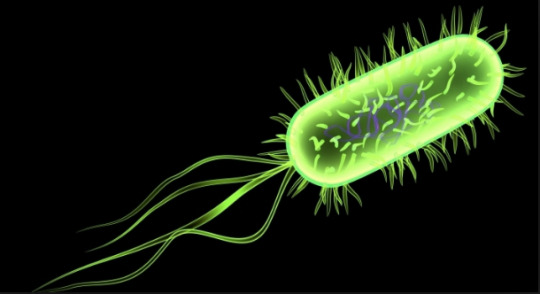
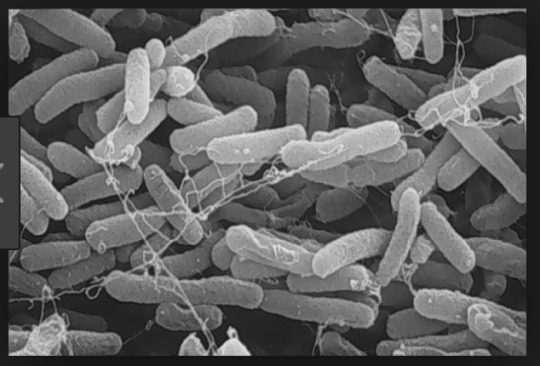
C. elegans

So this means that organisms which don't have naturally occurring GFP within them can be genetically engineered to have the gene which produces GFP inserted into them to make them glow.
This gene will be inserted and the organism and they will make their own GFP.
Fig 5 has had one of its genes replaces with the genetic code for GFP “This resulted in GFP being expressed in the worm, but only in the places in which the original gene would have been expressed.”
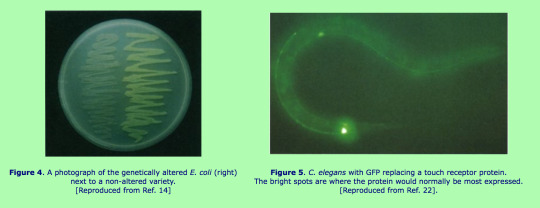
this shows that these organisms can be made to express their own form of the GFP using the gene extracted from the jellyfish. the GFP replaces the genes. changing the genetic code to one of GFP.

http://www.chm.bris.ac.uk/motm/GFP/GFPh.htm
https://theconversation.com/how-glow-in-the-dark-jellyfish-revolutionised-plant-biology-19118
0 notes
Text
Green Fluorescent Protein (GFP) was first isolated from the jelly fish, Aequorea victoria. The protein consists of 238 amino acid residues that fluoresce green when exposed to UV light. The gene for GFP was successfully inserted into E.coli bacteria in 1994 and the Nobel Prize in Chemistry 2008 was jointly awarded to Osamu Shimomura, Martin Chalfie and Roger Y. Tsien for the discovery and development of GFPs.
0 notes
Text
Green Fluorescent Protein (GFP) was first isolated from the jelly fish, Aequorea victoria. The protein consists of 238 amino acid residues that fluoresce green when exposed to UV light. The gene for GFP was successfully inserted into E.coli bacteria in 1994 and the Nobel Prize in Chemistry 2008 was jointly awarded to Osamu Shimomura, Martin Chalfie and Roger Y. Tsien for the discovery and development of GFPs.
0 notes
Text
You need to embrace this 1 thing if you want to become an expert in anything…including happiness!
Happiness…is it something you can become “expert” in?
Well, I’m not sure anyone can ever completely master happiness; at least not 100%, but that’s OK.
We can all “get better” at happiness, just like anything else, and here’s one of the most important tips for achieving this…
via Inc.com by Jon Levy
To uncover the secrets of success, everyone looks to industry experts and global influencers for answers. After all, they’ve been there and done that. However, replicating Oprah’s daily habit or waking up at 5 A.M. every morning won’t help you become an expert or achieve your own success.
After interviewing some of the most impressive people in the world for the Influencers podcast, one surprising admission kept popping up: Nobody knows what they are doing.
No one–no matter how talented and intelligent–starts out as an expert. Do you think Neil Degrasse Tyson was chatting about astrophysics from birth? That Stacy London has been a fashion icon since infancy?
Even after years of experience, they still make mistakes and experience failure like the rest of us. Contrary to what you may believe, their lack of certainty and awareness of it is the key to their success.
Here are three reasons why:
1. We learn more from being wrong.
Through experience and much trial and error, they’ve developed expertise, but that doesn’t mean that they are always right or even close. In reality, most are strongly familiar with failure and being wrong, because they’ve had to make countless mistakes to get to where they are now.
When I chatted with Nobel Prize winner Martin Chalfie, he said, “You have to deal with failure in every walk of life.” Embrace your failures and mistakes, because they could be what leads you to your greatest discovery yet…
…keep reading the full & original article HERE
0 notes
Text
2019年搞笑諾貝爾獎即將揭曉:今年的主題是“習慣”
馬克·亞伯拉罕對有趣和怪異的著迷還可以追溯到更久以前。亞伯拉罕成長於馬薩諸塞州的斯旺普斯科特(Swampscott),讀四年級時,他的好奇心被科學點燃了。他開始收集各種各樣“奇怪的東西”,包括一篇標題為《男子沖廁所,房子爆炸》的報紙文章,這些都讓年僅10歲的他得到想像力的極大滿足。
亞伯拉罕畢業於哈佛大學應用數學專業,現年78歲。當地時間9月12日,他將在哈佛大學桑德斯劇場主持第29屆首屆搞笑諾貝爾獎的頒獎典禮。法國《世界報》(Le Monde)稱亞伯拉罕為“不可思議科學的教皇”,《華盛頓郵報》則稱他為“美國學術垃圾的專家”。
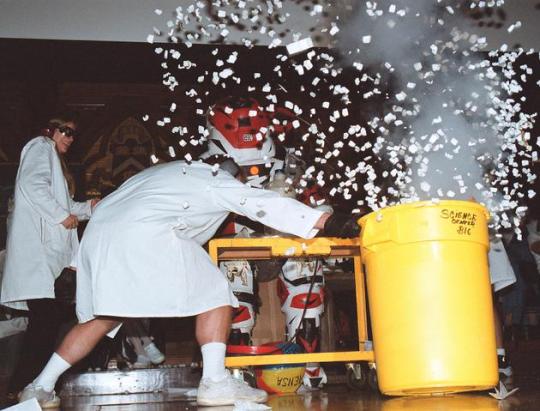
搞笑諾貝爾獎的頒獎典禮都很熱鬧,1999年,科學家在頒獎典禮上引爆一個裝滿五彩紙屑的大桶
往屆的獲獎者包括一位出生於烏克蘭的研究者,他設計了一種可以變成防毒面具的胸罩;一位對人類肚臍絨毛做過全面調查的澳大利亞科學家;還有一位發明了洗貓狗機器的西班牙發明家。
如今,亞伯拉罕是一位編輯兼作家,他說:“作為一個成年人,我要做所有我小時候最喜歡做的事情。”他的家庭辦公室裡擺滿了搞笑諾貝爾獎的紀念品。每年,亞伯拉罕都會像一位經驗豐富的領唱一樣,主持這場熱鬧的盛會,並精心策劃當晚的惡作劇。頒獎典禮中,還有觀眾向舞台投擲紙飛機,以及由真正的諾貝爾獎得主頒獎等傳統環節。
預計今年將出席頒獎典禮的諾獎得主包括2007年諾貝爾經濟學獎得主埃里克•馬斯金(Eric Maskin);1990年諾貝爾物理學獎得主杰羅姆·弗里德曼(Jerome Friedman );以及2008年諾貝爾化學獎得主馬丁·查爾菲(Martin Chalfie)。
不可思議的科學
搞笑諾貝爾獎頒獎典禮在諾貝爾獎頒獎前舉行,旨在表彰“乍看讓人發笑,之後發人深省”的科學成就,並強調科學甚至可以存在於一些荒謬的問題中,比如“嘆氣就只是嘆氣嗎?”(回答:不,這是一種無意識的消極情緒的表達,包括渴望、無聊、失望和失敗);或者“端著咖啡走動時,咖啡為什麼會溢出來? ”(答案:這是杯子運動和里面的低粘度液體動力學相互作用的結果)。
亞伯拉罕是科學幽默雜誌《不可思議研究年報》(Annals of Improbable Research)的聯合創始人兼編輯。 “我們把人們的注意力引向了一些可能根本得不到太多關注的事情,”他說,“諾貝爾獎得主會得到認可,但還有數百萬名科學家在推動科學,而他們中的大多數人根本得不到任何關注。”
舉個例子,有一群醫生研究了激烈接吻的生物醫學益處和後果,還有研究人員證明幾乎所有體重在3公斤以上的哺乳動物都在21秒內排空膀胱,甚至有科學家研究了馴鹿對偽裝成北極熊的人類的反應。
搞笑諾貝爾獎還表彰了那些沒有獲得應有認可的創新者。他們當中有卡拉ok的發明者,有提出墨菲定律的三個人,還有一個人和他的父親一起為“comb-over”髮型(把一邊頭髮全都梳到另一邊頭髮稀少的地方)申請了專利。
獲得搞笑諾貝爾獎並不容易。每年,亞伯拉罕和一組志願的評委都會評估數千項提名。一些被選中的人因為害怕在公眾面前難堪而拒絕接受該獎項,但大多數人都很激動,願意支付親自領取該獎項的旅費。
1991年,第一屆搞笑諾貝爾獎頒獎典禮在麻省理工學院的一間教室裡舉行,自此之後,這個活動就在全世界的科學家中逐漸贏得了聲望,而且一直很受歡迎。三年後,頒獎典禮搬到了哈佛大學桑德斯劇場,並且每年都在那裡舉行,觀眾爆滿。
起初,一些科學家痛斥搞笑諾貝爾獎,稱其是為了嘲笑科學研究,但真正的諾貝爾獎得主的出現消除了這種觀點。大多數科學家都會欣然接受這一獎項,因為這表明他們可以自嘲,並鼓勵人們對科學產生興趣。
“有些人認為我們是在攻擊科學,取笑科學家,”亞伯拉罕說:“但我們其實是在為科學家們辯護,他們試圖找出什麼是真實的,什麼是真實的,什麼是準確的。我們想讓人們對科學充滿好奇。人們會害怕他們不理解的東西,但如果他們在感到害怕之前擁有好奇心,科學就不會再讓他們感到害怕了。”
搞笑諾貝爾獎並不妨礙科學家獲得真正的諾貝爾獎。 2000年,英國曼徹斯特大學皇家學會研究教授安德烈•海姆(Andre Geim)因研究用磁懸浮技術使活青蛙浮起而獲得搞笑諾貝爾獎。十年後,他以石墨烯(一種比鋼強度更高的超薄材料)的開創性實驗獲得2000年諾貝爾物理學獎。
安德烈·海姆在自己的簡歷中列出了“搞笑諾貝爾獎得主”,他說:“坦白地說,我對搞笑諾貝爾獎和諾貝爾獎的評價是一樣的。對我來說,搞笑諾貝爾獎是我能開玩笑的表現;一點點的自嘲總是有幫助的。”
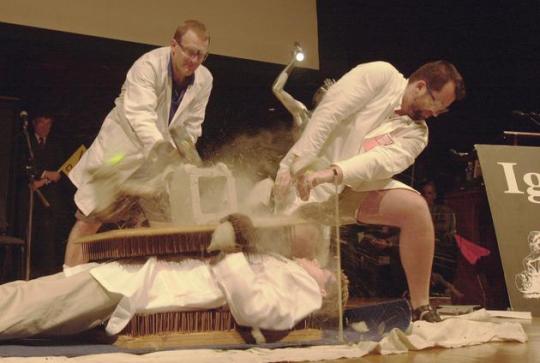
哈佛大學講師丹尼爾·羅森伯格(左)在2001年搞笑諾貝爾獎頒獎典禮上對同事尼爾斯·索倫森進行“胸口碎大石”,後者當時躺在釘床上
搞笑諾貝爾獎至今已舉辦了28屆,其獎項包括生物、醫學、物理、和平、經濟、文學等固定獎項,也包括公共衛生、考古、營養學等隨機獎項,所有獲獎的成果都是實際存在的研究。參與獎項評審的評委包括《不可思議研究年報》的編輯、各領域的科學家(包括幾位諾貝爾獎獲得者)、記者和多個國家不同領域的精英人士。創始人亞伯拉罕曾表示,搞笑諾貝爾獎的設立是為了表揚不尋常的研究、推崇想像力,並“激起人們對科學、醫學和技術的興趣”。
2019年搞笑諾貝爾獎頒獎典禮由《不可思議研究年報》主辦,由哈佛-拉德克利夫物理學生協會和哈佛-拉德克利夫科幻小說協會共同贊助,開始時間是美國東部時間9月12日下午6點(北京時間9月13日週五早上6點)。
想知道又不敢問的問題
在2019年的搞笑諾貝爾獎即將頒發之際,讓我們來回顧一些過往得獎的有趣成果。
2008年
營養學獎:好聽的食物也會比較好吃。吃薯片時聽到的咔嚓聲,能讓人感到薯片比實際的更新鮮脆爽。
2009年
和平獎:裝滿啤酒的啤酒瓶比空啤酒瓶更結實嗎?它們的斷裂閾值是否足以打破人類的頭骨?研究這兩種啤酒瓶打人的效果,有助於幫助法庭判斷二者造成的傷害。
2010年
和平獎:和很多人想像的一樣,罵人確實能夠緩解疼痛。
2011年
心理學獎:嘆氣就只是嘆氣嗎?其實,嘆氣可以作為對困難任務的情感信號反應。
2012年
流體力學獎:端咖啡走路如何不灑出來?除了人走路方式的影響外,咖啡晃動的情況還與加速度和扭矩等有關。
2013年
心理學獎:情人眼裡出西施?喝醉酒的人會認為自己變得更加迷人。
2014年
神經科學獎:在吐司上看到耶穌的臉?這證明了“人臉空想性錯視”的存在,當人們觀察到類似人臉的特徵時,某些神經元會活躍起來,將這些特徵整合成一張臉。
2015年
物理學獎:幾乎所有體重在3公斤以上的哺乳動物排尿時間都在21±13秒內,不隨身體大小而改變。
2016年
醫學獎:當你左邊身體癢時,可以通過照鏡子撓自己的右邊來緩解,反之亦然。
2017年
解剖學獎:為什麼老年人有大耳朵?男性30歲後,耳朵每10年都會生長約2毫米,相比女性而言,大耳朵更為顯眼。
2018年
醫學獎:藉由坐過山車可以加速腎結石排出。
.
from 2019年搞笑諾貝爾獎即將揭曉:今年的主題是“習慣”
via KKNEWS
0 notes